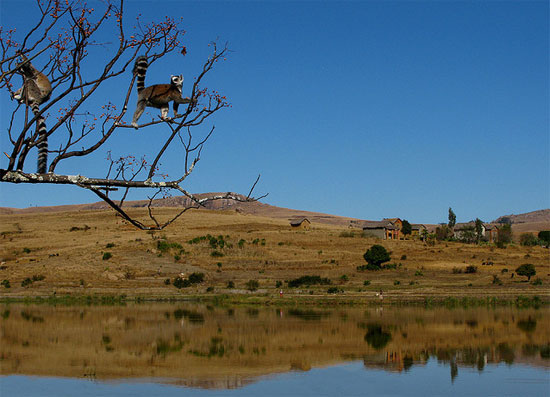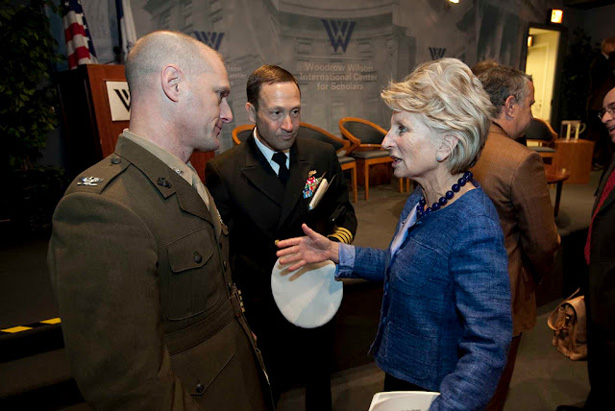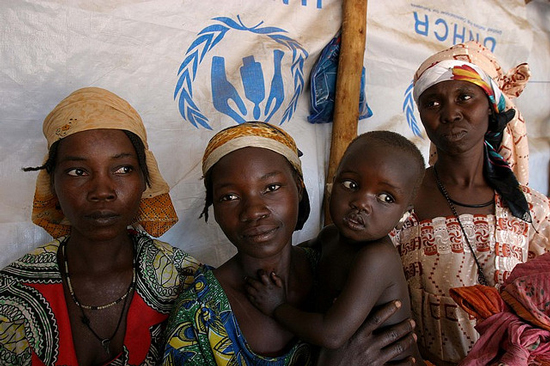-
Integrating Development: A Livelihood Approach to Population, Health, and Environment Programs
›
Rural communities in developing countries understand that high population growth rates, poor health, and environmental degradation are connected, said Population Action International’s Roger-Mark De Souza at a recent Wilson Center event. An integrated approach to development – one that combines population, health, and environment (PHE) programs – is a “cost-effective intervention that we can do very easily, that responds to community needs, that will have a huge impact that’s felt within a short period of time,” said De Souza. “This is how we live our lives, this makes sense to us – it’s completely logical,” community participants in PHE projects told him.
-
Madagascar, Past and Future: Lessons From Population, Health, and Environment Programs
›In Madagascar, “today’s challenges are even greater than those faced 25 years ago,” said Lisa Gaylord, director of program development at the Wildlife Conservation Society. At an event at the Woodrow Wilson Center on March 28, Gaylord and her co-panelists, Matthew Erdman, the program coordinator for the Population-Health-Environment Program at Blue Ventures Conservation, and Kristen Patterson, a senior program officer at The Nature Conservancy, discussed the challenges and outcomes of past and future integrated population, health, and environment (PHE) programs in Madagascar. [Video Below]
Nature, Health, Wealth, and Power
Gaylord, who has worked in Madagascar for nearly 30 years, gave a brief history of USAID’s activities on the unique island, which she called a “mini-continent.” She used the “nature, health, wealth, and power” framework to review the organization’s environment, health, and livelihoods programs in Madagascar and their results. Governance, she said, is the centerpiece of this framework, but this piece “maybe didn’t have an adequate foundation” in Madagascar to see the programs through the political crisis.
Though its programs started at the community level, Gaylord said USAID’s objective was to scale up to larger levels. “You can’t always work on that level and have an impact,” she said, and there was “tremendous hope” in 2002 for such scaling up when Madagascar elected a new president, Marc Ravalomanana.
Unfortunately, changes in funding, a lack of economic infrastructure, and poor governance forced development programs to scale down. After President Ravalomanana was overthrown in a military coup in 2009, the situation got worse – the United States and other donors pulled most funding, and only humanitarian programs were allowed to continue.
“What worries me is that I think we have gone back” to working on a village level, Gaylord said. “We want to go up in scale, and I think that we felt that we could in Madagascar, but that’s where you have the political complexities that didn’t allow us to continue in that direction.”
Going forward, Gaylord said that it is important to maintain a field-level foundation, take the time to build good governance, and maintain a balance in the funding levels so that no one area, such as health, dominates development activities.
Living With the Sea
Based in southwestern Madagascar, the Blue Ventures program began as an ecotourism outfit, said Erdman, but has since grown to incorporate marine conservation, family planning, and alternative livelihoods. One of its major accomplishments was the establishment of the largest locally managed marine protection area in the Indian Ocean, called Velondriake, which in Malagasy means “to live with the sea.” This marine area covers 80 kilometers of coastline, incorporates 25 villages, and includes more than 10,000 people. The marine reserves for fish, turtles, and octopus, as well as a permanent mangrove reserve, protect stocks from overfishing.
One of the biggest challenges facing the region is its rapidly growing population, which threatens the residents’ health and their food security, as well as the natural resources on which they depend. More than half the population is under the age of 15 and the infant and maternal mortality rates are very high, Erdman explained. Blue Ventures, therefore, set up a family planning program called Safidy, which means “choice” in Malagasy.
“If you have good health, and family size is based on quality, families can be smaller and [there will be] less demand for natural resources, leading to a healthier environment,” said Erdman.
The region’s isolation and lack of education and health services are a challenge, said Erdman, but over the past three years, the contraceptive prevalence rate has increased dramatically, as has the number of clinic visits. The program uses a combination of clinics, peer educators, theater presentations, and sporting events, such as soccer tournaments, to spread information about health and family planning.
A Champion Community
“There is a long history of collaborative work in Madagascar,” Patterson said. Focusing on the commune (county) level, she worked in conjunction with USAID, Malagasy NGOs, and government ministries to try to scale up PHE programs in Madagascar’s Fianarantsoa province, which has a target population of 250,000 people.
“We essentially worked at two different levels,” said Patterson. At the regional level, a coordinating body for USAID and local partners called the “Eco-Regional Alliance” met monthly. The “Champion Commune” initiative, which worked at local levels, had three main goals, she explained:
Though working in such remote areas is expensive, and all non-humanitarian U.S. foreign aid has been suspended since the coup, Patterson hopes that development programs will return to Madagascar. Pointing to its vast rural areas, she stressed the importance of integrated efforts: “The very nature of multi-sectoral programs is that they have the highest benefit in the areas that are most remote. These are the areas where people are literally left out in the cold.”- Create a strong overlap with neighboring communes;
- Promote activities that benefited more than one sector (such as reforesting with vitamin-rich papaya trees); and
- Capitalize on the prior experiences of Malagasy NGOs in implementing integrated projects to help build up civil society.
Image credit: “Untitled,” courtesy of flickr user Alex Cameron.
Sources: The New York Times, Velondriake. -
In Search of a New Security Narrative: National Conversation Series Launches at the Wilson Center
›The United States needs a new national security narrative, agreed a diverse panel of high-level discussants last week during a new Wilson Center initiative, “The National Conversation at the Woodrow Wilson Center.”
Hosted by new Wilson Center President and CEO Jane Harman and moderated by The New York Times’ Thomas Friedman, the inaugural event was based on a white paper by two active military officers writing under the pseudonym “Mr. Y” (echoing George Kennan’s “X” article). In A National Strategic Narrative, Captain Wayne Porter (USN) and Colonel Mark Mykleby (USMC) argue that the United States needs to move away from an outmoded 20th century model of containment, deterrence, and control towards a “strategy of sustainability.” [Video Below]
Anne-Marie Slaughter of Princeton University, who wrote the white paper’s preface, summarized it for the panel, which included Brent Scowcroft, national security adviser to President Ford and President H.W. Bush; Representative Keith Ellison (D-Minn.); Steve Clemons, founder of the American Strategy Program at the New America Foundation; and Robert Kagan, senior fellow for foreign policy at the Brookings Institution.Framing a 21st Century Vision
We can no longer expect to control events, but we can influence them, Slaughter said. “In an interconnected world, the United States should be the strongest competitor and the greatest source of credible influence – the nation that is most able to influence what happens in the international sphere – while standing for security, prosperity, and justice at home and abroad.”
“My generation has had our whole foreign policy world defined as national security,” said Slaughter, “but ‘national security’ only entered the national lexicon in the late 1940s; it was a way of combining defense and foreign affairs, in the context of a post-World War II rising Soviet Union.”
As opposed to a strategy document, their intention, write Porter and Mykleby, was to create a narrative through which to frame U.S. national policy decisions and discussions well into this century.
“America emerged from the Twentieth Century as the most powerful nation on earth,” the “Mr. Y” authors write. “But we failed to recognize that dominance, like fossil fuel, is not a sustainable source of energy.”It is time for America to re-focus our national interests and principles through a long lens on the global environment of tomorrow. It is time to move beyond a strategy of containment to a strategy of sustainment (sustainability); from an emphasis on power and control to an emphasis on strength and influence; from a defensive posture of exclusion, to a proactive posture of engagement. We must recognize that security means more than defense, and sustaining security requires adaptation and evolution, the leverage of converging interests and interdependencies. [italics original]
Prosperity and Security a Matter of Sustainability
The “Mr. Y” paper is similar in some respects to other strategic documents that have promoted a more holistic understanding of security, such as the State Department’s Quadrennial Diplomacy and Development Review, which was partially authored by Slaughter during her time in State’s Policy Planning Office. But there’s a markedly heavy focus on economics and moving beyond the “national security” framework in Porter and Mykleby’s white paper. They outline three “sustainable” investment priorities:
“These issues have come in and out of the security debates since the end of the Cold War, but they have not been incorporated well into a single national security narrative,” Geoff Dabelko, director of the Wilson Center’s Environmental Change and Security Program, told The New Security Beat. “This piece is a positive step toward achieving a coherent and inclusive national security narrative for the United States.”- Human capital: refocus on education, health, and social infrastructure;
- Sustainable security: use a more holistic, whole-of-government approach to security; essentially, expand the roles of civilian agencies and promote stability as much as ensuring defense; and,
- Natural resources: invest in long-range, sustainable management of natural resources, in the context of expanding global demand (via population growth and consumption).
To provide a “blueprint” for this transition, Porter and Mykleby call for the drafting of a “National Prosperity and Security Act” to replace the national security framework laid by the National Security Act of 1947 (NSA 47) and followed by subsequent NSAs.A New Geostrategic Model?
The panel unanimously praised the white paper’s intentions, if not its exact method of analysis and proposed solutions. All agreed that globalization and technology have helped create a more interconnected and complex world than current foreign policy and national security institutions are designed to deal with. Scowcroft called the 20th century “the epitome of the nation-state system” and said he expects an erosion of nation-state power, especially in light of integrated challenges like climate change and global health.
Kagan disagreed, saying he’s less convinced that the nation-state is fading away. “If anything, I would say since the 1990s, the nation-state has made a kind of comeback,” he said, adding that the paper lacks “a description of how the world works, in the sense of ‘do we still believe in a core realist point that power interaction among nation states is still important?’” In that sense, he said, “I’m not at all convinced we’ve left either the 20th century or the 19th century, in terms of some fundamental issues having to do with power.”
“I think there are three things that really are new,” said Slaughter. “The first [is the] super-empowered individual…the ability of individuals to do things that only states could.” We saw that with 9/11, with individuals attacking a nation, and we’re seeing that with communications as well, she said. “I can tell you, Twitter and the State Department’s reporting system, they’re pretty comparable and Twitter’s probably ahead, in terms of how much information you can get.”
Second, there is a “whole other dimension of power that simply did not exist before and that is how connected you are,” Slaughter said. “The person who is the most connected has the most power, because they’re the person who can mobilize, like Wael Ghonim in Egypt.”
Third, there are a greater number of responsible stakeholders. “What President Obama keeps telling other nations is ‘you want to be a great power? It’s not enough to have a big economy and a big army and a big territory, you have to take responsibility for enforcing the norms of a global order,’” Slaughter said. Qatar’s willingness to participate in the international community’s intervention in Libya, she said, was in part an example of a country responding to that challenge and stepping up into a role it had not previously played.
These new dimensions to power and security don’t entirely replace the old model but do make it more complex. “It’s on top of what was,” Slaughter said, and “we have to adapt to it.”
Photo Credit: Colonel Mark Mykleby (USMC), Captain Wayne Porter (USN), and Wilson Center President and CEO Jane Harman, courtesy of David Hawxhurst/Wilson Center. -
Watch: Elizabeth Leahy Madsen Explains the Demography-Civil Conflict Interface in Less Than Two Minutes
›April 12, 2011 // By Schuyler Null“We know that historically, as well as in the present, countries that have very young age structures – those that have youthful and rapidly growing populations – have been the most vulnerable to outbreaks in civil conflict,” said Elizabeth Leahy Madsen, senior research associate at Population Action International, in an interview with ECSP. “It’s not a simple cause and effect relationship, but we think that demographic trends and pressures can exacerbate underlying conditions.”
-
What “Lost” Cultures Can Contribute to Management of Our Planet
›
“Climate change is not a technical problem for indigenous people – it’s a psychological and spiritual problem,” said Wade Davis, explorer-in-residence at National Geographic, at a recent Wilson Center event, the third in a series co-sponsored by George Mason University and the Environmental Change and Security Program. Indigenous people are “being driven out of existence,” as climate change alters landscapes and weather patterns that they have carefully adapted to over centuries, he said. These people are not “failed attempts at being modern…they are unique answers to the fundamental question, ‘what does it mean to be human and alive?’” he said. “It behooves us to pay attention to how they choose to live upon the earth.” [Video Below]
-
Working With the Private Sector to Improve Maternal, Newborn, and Child Health
Innovations From Development to Delivery
›“Challenging and dynamic partnerships [with the private sector] are difficult to pull together, but when you look at sustainability, impact, and effectiveness, they can also be great levers of change,” said Kari Stoever, senior advisor for global advocacy at the Global Alliance for Improved Nutrition (GAIN) at the Wilson Center on March 22. [Video Below]
Stoever was joined by panelists Laura McLaughlin, environmental engineer at Cascade Designs, Inc., Hugh Chang, director of special initiatives at the NGO PATH, and Laura Birx, senior food security and nutrition specialist at the U.S. Agency for International Development (USAID) for a discussion of the private sector’s role in developing innovative health technologies to increase access to safe water, prevent infectious diseases, and improve maternal health nutrition.
Collaborating to Provide Safe Water
“NGOs have different strengths and different perspectives from the private sector, and we’ve found an area where we can really complement each other,” said McLaughlin. Cascade Designs, Inc., collaborated with PATH to create a smart electrochlorinator, which produces a chlorine solution to purify water using just salt water and a simple battery, because “we wanted to make a bigger difference than we could do with philanthropy alone,” said McLaughlin.
“Products need to be designed specifically for the end user, particularly for women and children, who are often times left out of the design process,” said McLaughlin. Cascade’s smart electrochlorinator was designed with this in mind. One charged battery can treat up to 40,000 liters of water, 200 liters at a time. The device is easy to use, requires simple resources, is significantly more affordable than existing solutions, and lends itself to an entrepreneurial business model that can deliver safe water to small community households. The current prototype is being field-tested in 10 countries globally, with the aim of providing safe water in resource-poor communities while generating income for local entrepreneurs.
The PATH-Cascade partnership was successful in part because it combined “private-sector expertise in efficiency, cost-effectiveness, and meeting market demands” with knowledge about the health needs in developing countries, said McLaughlin. By “pushing each other to a common end goal, this partnership really multiplied our strengths.”
Engaging the Private Sector
“One of the reasons we work closely with the private sector…is because we recognize an efficiency of resource usage that comes with building bridges between the public sector and the private sector,” said Chang of PATH’s work with Cascade and others. Engaging the private sector to advance health technologies can complement PATH’s goals, like encouraging healthy behaviors and strengthening health systems, he said. “But, we are not averse to profits,” he added, stressing that partnerships with NGOs can be mutually beneficial. “We understand for this to be sustainable, these companies need to make a profit.”
PATH is working with the private sector to develop injection and vaccine technologies that “produce a product that not only benefits the recipient of the vaccine but also produces a revenue stream,” said Chang. The SoloShot, for example, is a low-cost, disposable syringe that locks after a single injection, preventing needle reuse and contamination that can increase the risk of HIV, hepatitis B, and other infections. To address the challenge of maintaining the proper refrigeration of vaccines in low-resource settings, private sector collaboration has helped to develop the vaccine vial monitor (a sticker that changes color when a vaccine has been exposed to too much heat) and to create more stable vaccine formulas that are less vulnerable to extreme temperatures. “By combining innovation with on-the-ground presence,” concluded Chang, “private sector engagement can be a powerful tool for global health.”
A “Win-Win Partnership”
“There is a tremendous role for the private sector to play in the intersection of agriculture and health as they relate to nutrition,” said Birx. Engaging the private sector can be a “win-win partnership,” she said. The Obama Administration’s hunger initiative, Feed the Future, for example, uses the resources, expertise, and innovation of the private sector to encourage sustainable, market-driven approaches to reducing poverty and food insecurity, said Birx.
USAID sees innovation as a “research-to-use continuum,” said Birx. “When we look at innovation, it’s not just about the development of a specific product, but about the entire system that goes around that product,” she added. New technologies must not only respond to a major development challenge in poor and rural communities but need to be affordable, culturally appropriate, gender sensitive, easy to use, and durable.
But solutions don’t have to be complicated. “Often times it’s about a really simple technology that can improve accessibility,” said Birx. The nevirapine pouch, for example, a simple foil packet that allows health care workers to give women single doses of nevirapine syrup, can reduce the risk of mother-to-child transmission of HIV by more than half.
“There’s a lot of excitement, but we need to do some serious work to capitalize on [it],” said Birx. Moving forward, health, development, and private-sector organizations must work together to create innovative financing mechanisms, build institutions in developing countries, and encourage enabling policy environments.
Sources: PATH.
Photo Credit: “Mission to Ouanda Djallé,” courtesy of flickr user hdptcar. -
Watch: Dan Smith on How International Alert Builds Peace
›April 6, 2011 // By Schuyler NullAddressing violent conflict is complex and difficult, but one universally important aspect of any peacebuilding operation is to understand the unique context of each situation, said Dan Smith, secretary general of International Alert, in this interview with ECSP. International Alert is a London-based NGO that works in 23 countries and territories in West and Central Africa, the Southern Caucasus, Central Asia, Nepal, Sri Lanka, and the Philippines.
The goal of International Alert, said Smith, is to help people “move from situations of danger and vulnerability…towards positions of greater safety.” In addition, the NGO tackles broader international policy questions, he said, such as how to manage and minimize the risks of conflict and hasten recovery from it.
Peacebuilding defies simplification, said Smith, but there are two broad recommendations to keep in mind. First, “going in with a preset form of analysis or of the action you will undertake, or the problems you will look at,” is the most significant mistake international actors can make. “If you’re a hammer, every problem for you is going to be a nail,” he said. “But there are many countries where you need screwdrivers or monkey wrenches… you’ve got to be open-minded about that.”
Second, “realize that the outsider, like us, is not going to make peace or build peace in a country – it’s the people there who are going to do it,” said Smith. The international community’s job is to assist.
“Sometimes it’s as simple as experience from other places,” he said, which can be provided by an NGO and transferred from one context to another. “As long as you don’t shove it down anybody’s throats – it’s always an assisting and a helping role.” -
Tunisia Predicted: Demography and the Probability of Liberal Democracy in the Greater Middle East
›
In 2008, demographer Richard Cincotta predicted that between 2010 and 2020 the states along the northern rim of Africa – Morocco, Algeria, Tunisia, Libya, and Egypt – would each reach a demographically measurable point where the presence of at least one liberal democracy (and perhaps two), among the five, would not only be possible, but probable. Recent months have brought possible first steps to validate that prediction. [Video Below]
Showing posts from category video.









